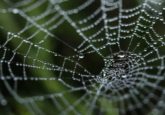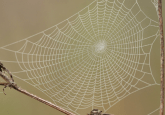Spider silk’s spectacular healing powers

UK researchers demonstrate a method for “dressing up” spider silk to aid tissue regeneration. Will this biomedical super material catch on for dressing wounds?

Fluorescently labeled spider silk fibers. Courtesy of David Harvey and Neil R. Thomas.
Spider silk is, weight per weight, one of the toughest and most flexible materials known on Earth. The silk also possesses unique biodegradable, non-inflammatory, and non-antigenic activities that researchers long to optimize for medical purposes.
Now in the journal Advanced Materials, researchers from the University of Nottingham report using click chemistry to decorate spider silk synthesized by E. coli with certain molecules that enrich the silk.
“What we brought was the use of chemistry to decorate the spider silk in a wide variety of different ways, such as producing antibiotic spider silk,” said Neil Thomas, who led the study. “This may be used as dressings that could keep wounds free of pathogenic bacteria and simultaneously provide a scaffold for new cell growth before degrading in the wound, hence accelerating the healing of wounds along the way.”
Thomas’ lab functionalized their spider silk by replacing methionine in recombinant miniature spider silk proteins with an unnatural amino acid, called L-azidohomoalanine (L-Aha), which contains an azide group required for copper-catalyzed chemical click reactions.
The team showed that either fluorescent molecules or the antibiotic levofloxacin could be “clicked” onto the silk proteins, which can then be assembled into fibers. Alternatively, the fibers could be formed first and then modified with ligands.
The levofloxacin-decorated fibers included a linker between the antibiotic andsilk that breaks down in the acidic environment typically produced by growing bacteria. This enabled the levofloxacin to be released in two phases—a short initial antibiotic burst from the levofloxacin adsorbed on the fibers, followed by sustained release lasting at least 5 days as the linkers break down.
Thomas’ team is now exploring other ways to modify spider silk. “We are currently looking at our modified silks as scaffolds for stem cell growth and tissue regeneration, but I think we need around 5 years before we would be looking at these in the first phases of testing in humans,” said Thomas.


